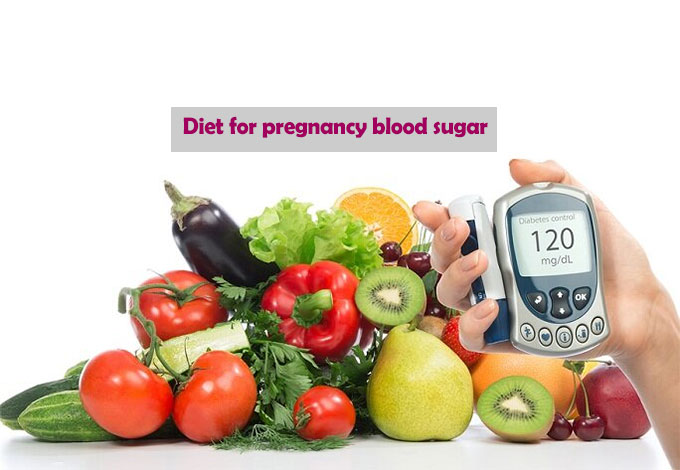What is gestational diabetes and how can it be controlled?

What do you know about the symptoms of gestational diabetes? What’s the best breakfast for gestational diabetes? Does this disease have complications in the fetus? Is it possible for the fetus to suffer from blood sugar after birth? In this article, we will discuss the complete examination of blood sugar during pregnancy.
What is gestational diabetes?
During pregnancy, blood sugar levels may increase in some women. This condition, known as gestational diabetes mellitus (GDM), usually develops between the 24th and 28th weeks of pregnancy.
According to data from the US Centers for Disease Control and Prevention (CDC), this condition is estimated to occur in 2-14 percent of pregnancies in the United States. Having gestational diabetes during this period of life does not mean that you had diabetes before your pregnancy or that you will develop diabetes later.
But gestational diabetes increases the risk of developing type 2 diabetes in the future. If this disease is not managed well, it can increase the possibility of your child developing high blood sugar, as well as the possibility of serious complications for you and your fetus during pregnancy and childbirth.
Related posts: What Causes Belly Button Pain During Pregnancy?
Types of gestational diabetes
Gestational diabetes is generally divided into two categories:
- Class A1 is used to describe gestational diabetes that can only be controlled with diet.
- Class A2 is used to describe gestational diabetes in which insulin or other oral medications are used to control the disease.
If you have gestational diabetes, it is better to check the list of endocrinologists or gynecologists or discuss your problem with your doctor through an online consultation.
Symptoms of gestational diabetes
This condition is rarely accompanied by symptoms, and if it does occur, it will be accompanied by mild symptoms.
Symptoms of gestational diabetes in the first trimester:
Excessive growth of the fetus in this period begins before the diagnosis of gestational type 2 diabetes, and it is necessary to check for “impaired glucose tolerance” at the beginning of this period.
A person with glucose intolerance may have normal or slightly elevated fasting blood sugar levels. Be patient, I will tell you about the first and second types of this disease soon.
If you do HbA1c, which is a type of blood test that shows how well patients are managing their diabetes, in the first trimester of pregnancy can assess their condition earlier and provide an opportunity to manage and prevent gestational diabetes.
Since this type of diabetes occurs three months after pregnancy, you usually won’t notice any particular symptoms during this time.
Symptoms of gestational diabetes in the second trimester:
An increase in a pregnant mother’s blood glucose level in the second trimester of pregnancy is one of the main symptoms of blood sugar in pregnancy. Sometimes, like most pregnant women, you may not have any symptoms of diabetes in the second trimester.
That’s why your doctor should write you a test for a better diagnosis. Usually, between the 24th and 28th weeks of pregnancy, this problem becomes severe. With this test, you can check your blood glucose level.
Symptoms Of Gestational Diabetes In The Third Trimester:
- Fatigue
- Blurry vision
- Excessive thirst
- Nausea
- Excessive need to urinate
- Vaginal, bladder, and skin infections
Causes of gestational diabetes
At present, the exact cause of high blood sugar is not known, but hormones likely play a role. Hormones produced in large quantities during pregnancy include:
Human Placental Lactogen (HPL) and other hormones increase insulin resistance. These hormones help maintain pregnancy by influencing the placenta. Over time, the amount of these hormones in a pregnant mother’s blood increases and can make the body resistant to insulin (a hormone that regulates blood sugar).
The insulin hormone helps to transfer glucose from the blood to cells and provides energy. During pregnancy, the body is naturally slightly resistant to making more glucose in the bloodstream available to transmit to the fetus. But if the resistance to insulin is excessive, the mother’s blood sugar level can increase abnormally, which can cause gestational diabetes.
To save time, you can report your problem through an online consultation with an endocrinologist or an online consultation with a gynecologist and start the treatment process.
Gestational diabetes diagnosis
Some doctors start the diagnosis with a glucose challenge test. As recommended by the American Diabetes Association (ADA), doctors generally test pregnant women for symptoms of high blood sugar during pregnancy. But if there’s no known history of diabetes and normal blood sugar levels in early pregnancy, your doctor will likely postpone this test until weeks 24-28 of your pregnancy.
Treatment of diabetes in pregnancy
After diagnosing gestational diabetes, the doctor will adjust an appropriate treatment plan for the pregnant mother, depending on her blood sugar level during the day.
During pregnancy, it may be difficult for you to visit the ob-gyn’s office in person. For better follow-up and to speed up the correct diagnostic process, you can use the online gynecological consultation service.
In most cases, your doctor will advise you to check your blood sugar with a glucometer before and after eating and to manage your condition by eating a nutrient-dense diet and exercising regularly. Shots of insulin can be added to these as needed until delivery.
If you inject insulin, ask your doctor about the appropriate time to inject, in relation to meals and exercise, to avoid hypoglycemia. If your blood sugar is too low or consistently above the prescribed level, your doctor will advise you.
Diet for pregnancy blood sugar
The golden key to proper blood sugar control during pregnancy is to eat a balanced diet. Eating regularly (often every 2 hours) can also play an important role in controlling blood sugar levels. In particular, you should pay special attention to the consumption of carbohydrates, proteins, and fats.

Carbohydrate intake in people with gestational diabetes
Proper spacing between carbohydrate-rich foods helps prevent blood sugar spikes. The doctor determines the exact amount of carbohydrate consumption per day. He or she may also recommend seeing a nutritionist to help establish an eating plan for gestational diabetes.
Carbohydrates that promote patient health include:
- Whole grains
- Brown rice
- Low-sugar fruit
- Beans, peas, lentils, and other legumes
- Starchy vegetables
sugar diet during pregnancy
Pregnant women should try to consume 2-3 servings of protein per day.
The amount of protein consumed by people with gestational diabetes
Pregnant women should aim to consume 2-3 servings of protein per day. Good sources of protein include:
- Lean meat
- Chicken
- Fish
- Tofu
However, the American College of Obstetricians and Gynecologists (ACOG) lists some types of fish you should avoid (due to their high mercury content).
Fat levels in people with gestational diabetes
Healthy fats that you should include in your diet include:
- Nuts without salt
- Grains
- Olive oil
- Avocado

Exercise and physical activity in people with gestational diabetes
As mentioned, exercise can help control blood sugar levels and improve outcomes for the mother and her baby. During exercise, the muscles’ consumption of glucose increases, and when this effect wears off, the muscles become more sensitive to insulin for a time and as a result, blood sugar levels decrease.
For this purpose, it is better to do light activities such as stationary bikes, yoga, and short daily walks of 15 to 30 minutes.
Who is at risk for gestational diabetes?
Women with the following conditions may be more susceptible to gestational diabetes:
- High blood pressure
- Family history of diabetes
- Excess weight before pregnancy
- Excessive weight gain during pregnancy
- Multiple pregnancies
- The birth of a previous child weighing 4 kg.
- Previous gestational diabetes
- Miscarriage or unexplained fetal death
- Taking steroids such as glucocorticoids
- Have polycystic ovary syndrome (PCOS), Acanthosis Nigricans (a skin condition characterized by dark, velvety discoloration of body folds), or other conditions associated with insulin resistance.
- Belonging to certain races and ethnicities (for example, being African, Native American, Asian, Pacific Islander, Hispanic, or Native Hawaiian)
Benefits of managing gestational diabetes
You must be under the supervision of a doctor during pregnancy and have your blood sugar (GGM) checked regularly.
The purpose of blood sugar control during pregnancy
Checking your blood sugar before and during pregnancy is the best thing you can do for yourself and your baby.
Good blood sugar control during pregnancy helps to :
1- Reduce the risk of miscarriage
Proper blood sugar control reduces the risk of miscarriage and stillbirth. The risk of miscarriage and stillbirth is higher in people whose diabetes is not controlled. Instant blood glucose monitoring is mandatory from the beginning of pregnancy until delivery and reduces the possibility of many risks, including miscarriage.
2- Reduce the risk of preterm birth
The better you control your blood sugar, the less likely you are to give birth prematurely.
3. Reduce the risk of birth defects
Checking your blood sugar before and during pregnancy greatly reduces the risk of birth defects, especially those affecting the brain, heart, and spine.
4. Reduce the risk of fetal overgrowth
High blood sugar causes more glucose to pass through the placenta. As a result, the child’s weight is higher than the average. The high weight of the baby makes natural birth difficult, increases the risk of cesarean section, and puts the baby at risk during delivery.
5. Prevents complications for the mother
Controlling blood sugar reduces the risk of urinary tract infections and yeast infections. It also prevents complications of diabetes such as kidney failure.
6. It prevents complications for the fetus
Babies born to mothers with diabetes sometimes experience hypoglycemia (low blood sugar) because their body’s production of insulin is high. Controlling blood sugar helps the health of blood sugar and the amount of calcium and magnesium in the blood of the fetus.
Controlling blood sugar helps to prevent respiratory disorders and yellowing of the skin and eyes (jaundice) in newborns after birth.
Necessary Measures to control gestational diabetes
You must be under the supervision of a doctor during pregnancy and have your blood sugar (GGM) checked regularly. Sometimes it is necessary not only to take care of blood sugar but also to control blood pressure. If you have high blood pressure, certain medications (such as angiotensin-converting enzyme inhibitors) may be prescribed. It is necessary to take the medicines under the supervision of a gynecologist.
To reduce the risk of preeclampsia, aspirin may be prescribed. Make sure you take your medications on time and do not stop them yourself.
If your blood sugar is high, your doctor will prescribe insulin. Make sure you inject the prescribed dose of insulin so that your fetus’ growth is not affected.
Make sure you have a diet rich in fruits, vegetables, and whole grains. Try to increase the number of your meals instead of eating a large amount of food in one meal. Check your weight.
Exercise during the week. Aerobic exercises such as aerobics and yoga are beneficial for both the health and development of the fetus.
Complications of gestational diabetes
Uncontrolled gestational diabetes can cause blood sugar levels to rise during pregnancy and cause complications that have negative effects on the health of the mother and baby.
For example, when your baby is born, you may have the following problems:
- High birth weight
- Low blood sugar
- Shoulder dystocia, which causes the baby’s shoulders to get stuck in the birth canal during delivery
- Respiratory problems
Additionally, these children may be at risk of developing diabetes in the future. For this reason, be sure to take steps to control your gestational diabetes by following the treatment plan recommended by your endocrinologist.
The effect of fetal gender on gestational diabetes
Gestational diabetes is higher in mothers with a male fetus because this fetus, with weaker beta-cell function, is associated with a higher postprandial glycemic index in the pregnant mother and with an increased risk of GDM in her; Thus, fetal sex has the potential to influence maternal glucose metabolism during pregnancy.
According to the research carried out, the probability of infection in women who had a male child was three percent higher than that of mothers with a female fetus.
Prevention of gestational diabetes
It is not possible to completely prevent high blood sugar during pregnancy. However, adopting health-promoting habits can help reduce the risk of developing this disease.
If you are pregnant and have any of the risk factors for gestational diabetes, try to eat a nutritious diet and get regular exercise. Even light activities, such as walking, can help in this regard.
If you’re trying to get pregnant and are overweight, be sure to talk to a health professional about safe ways to lose excess weight and prepare for pregnancy to help you create a plan for achieving and maintaining a moderate weight. Even a small amount of weight loss can help reduce the risk of gestational diabetes.
In addition, it is important for pregnant women to seek prenatal care and to have all necessary tests and evaluations during pregnancy.
What is gestational diabetes and how is it treated?
What causes gestational diabetes?
What is the best treatment for gestational diabetes?
What does gestational diabetes do to the baby?
Conclusion
In conclusion, gestational diabetes is a type of diabetes that develops during pregnancy and can lead to serious health complications for both the mother and the baby if left untreated. However, it can be effectively controlled through lifestyle changes, such as healthy eating habits and regular physical activity, as well as medical interventions such as insulin therapy. It is important for pregnant women to be screened for gestational diabetes and to work closely with their healthcare provider to manage the condition and ensure a healthy pregnancy and delivery.
